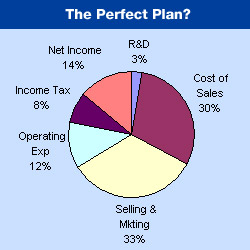
A couple years ago I did a basic study of some well branded companies just to see what they spend on sales and marketing. The results … just might be the perfect plan.
At the very least, you can get a real idea of what an optimum mix of expenses and profit might be when you sit down to write your own business plan.
How I Chose The Companies
My first criteria for this little weekend study was access to financial statements, so they’re all public companies. The figures are all from 2002. The kind of companies I wanted to get figures for were ones with well known brands. Premium brands.
Only a premium branded product can command a high enough price to contribute to a significant sales and marketing budget. The other key business model that successful companies employ is to take that budget and reduce their market price and play the undercutting game.
Selling on price alone without giving your distributors or retailers any market support is a tough game to play. It’s a lot easier to get your foot in the door with a premium brand. The reason is, a lot of the sales and marketing budget is going to go to the retailers in the form of advertising dollars. They love it when you pay for an ad in their weekly flyer and do in store promotions.
The Companies And What They Spend On Sales And Marketing
1. Nautilus
Nautilus makes fitness equipment. If you go to the gym, you’ve probably used it. They also make Bowflex and after buying the well known bicycle maker Shwinn, they extended their brand offerings extensively into a number of different price categories.
They spent 24.8% of their net sales on sales and marketing.
2. LVMH
Moet Hennessy Luis Vuitton makes wines and spirits, fashion, perfume, cosmetics, watches, jewelry, and they own a large number of retail outlets.
They spent 37.1% of net sales on sales and marketing
3. Swatch
If Andy Warhol, Dali and Picasso got together to form a watch company, it’d be Swatch. Their wild and endless assortment of pop designs have created a solid brand by bringing uniqueness to their brand again and again.
They spent 50.9% on sales and marketing
4. The Other Companies
I also threw Amer Sports, Shimano, Sony and IBM into the mix. They all lump their sales and marketing costs into operating costs or cost of sales, which makes it a little harder to extract specific numbers. But by looking at their other expenses, I got a pretty good idea of what they were.
Summing It All Up
It’s good to throw a bunch of numbers into the blender once in a while and see what comes out. When you compare them with sound analysis, they should be in the same ballpark.
The pie chart at the beginning of the post is an average of all these top-tier companies. The study showed that on average, they spend about 33% on sales and marketing and pull in a profit of around 14%. Together, this is in the same ballpark as the 50% margin that’s a standard target when you cost out a new product during development.
The really important thing I want to illustrate here is the cost of sales and marketing. You have to spend some money to make some money. And you only make money by selling.
So it makes sense to spend a good portion of your budget on selling.

As a child once I had asked my Dad as to why companies waste such a lot of money on sales and marketing, a good product would sell anyway, little knowing at that time that I was going to be a sales person all my life…lol. Dad answered saying ” a fish lays thousands of eggs and no one ever comes to know of it, a hen on the other hand lays one egg and the whole neighborhood gets to know about it” he continued ” most companies are capable so designing good products but it takes a lot of sales and marketing to get it off the shelf”. That made sense.
Most of the top brands anywhere in the world are the highest spenders on advertising and as I always mention, equally important is the after sales support. I would never touch a compaq (compuke) or hp again.
I was a little surprised by Swatch figures though, 50.9%.
Good post mate, take care and cheers.
Hey Robin,
The Swatch figure is pretty high. It’s hard to know what might be lumped into that figure. A lot of public companies try and hide their exact expenditures … there’s already so much information available about them to competitors.
Eggs. That’s a great analogy! If no one sees it, it might as well not exist. It always staggers me; the number of companies that spend huge money on development and infrastructure, and then see sales and marketing expenses as unnecessary and frivolous.